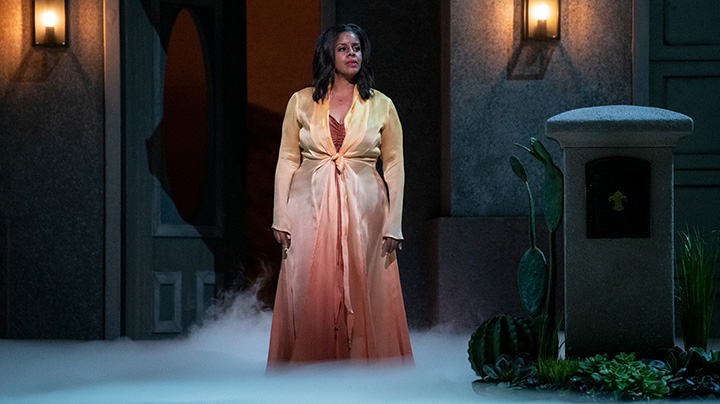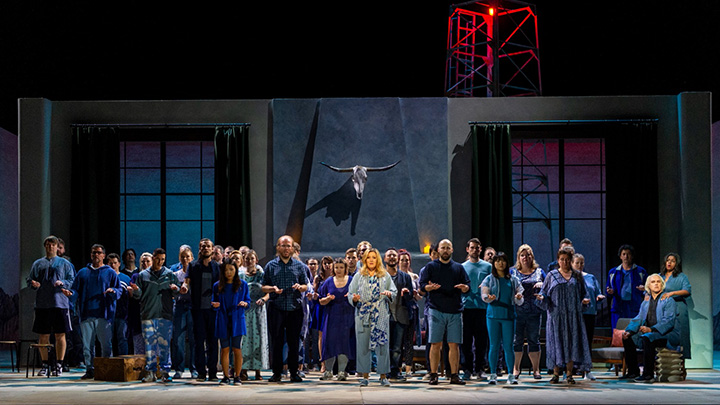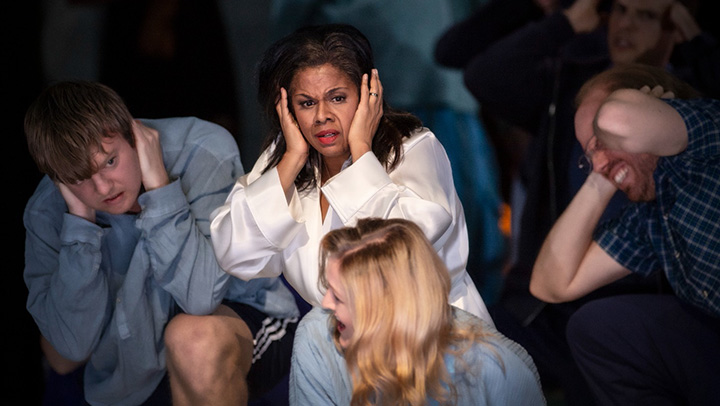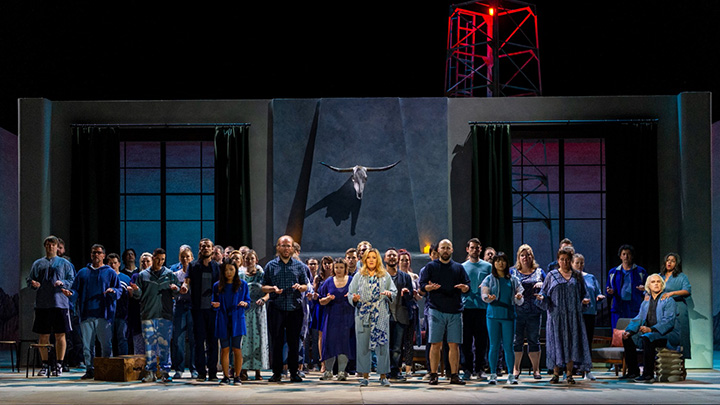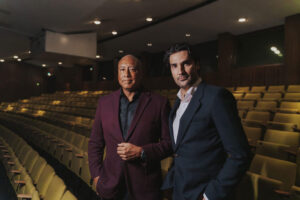On a quiet night in a southwest American suburb, a woman emerges from her house, clad only in her nightgown, and sings, beseechingly, to the coyote on her lawn. The woman is hearing a constant, unbearable humming sound, loud enough to keep her from sleep, to drive her out into the night.
At first, she thought it was the refrigerator—then, perhaps, the water heater or the air conditioning unit. She even went to the fuse box and cut the power. Hushed, she confides: “for one single second, I thought it stopped.” But it doesn’t stop. It never stops. The sound crashes through her brain until she howls like the coyote whose natural desert habitat has been transformed into suburban sprawl.
The woman is Claire Devon, the protagonist of The Listeners, a new opera by composer Missy Mazzoli and librettist Royce Vavrek, set to make its US premiere at Opera Philadelphia on September 25th. On the Sunday before last, at a Works & Process panel at the Guggenheim Museum, soprano Jasmine Saunders performed Claire’s aria, with Mazzoli’s characteristic thrumming orchestral compositions hinted at by Grant Loehnig’s piano accompaniment; in Philadelphia and in March at the Lyric Opera in Chicago, the role will be played by Nicole Heaston, who originated the role in its Norwegian National Opera premier.
The Listeners, based on a story by the author Jordan Tannahill, follows Claire Devon, a suburban schoolteacher and mother who begins to hear a mysterious and maddening hum, a constant low-frequency sound that drives her frantic, even as most of the people around her cannot hear it at all. Claire finds a community of fellow sufferers—the “Listeners” of the opera’s title—led by the charismatic Howard. Howard and the Listeners promise Claire connection, a chosen family for Claire to rely on when the hum has driven her away from her husband and daughter. As the show goes on, the group becomes increasingly cultish and dangerous.
This synopsis of The Listeners is reminiscent of another story about a woman whose inexplicable and devastating ailment pushes her out of the suburbs and into the arms of cult quackery. In Todd Haynes’s 1995 film Safe, Julianne Mooreplays Carol White, an affluent suburban housewife who develops a mysterious and debilitating illness, seemingly some kind of environmental illness triggered by the constant haze of chemicals that suffuses contemporary life. With her doctors insisting nothing is wrong with her physically, Carol ends up in a desert retreat for the chemically sensitive, led by a new age sage, played with gentle menace by Peter Friedman, who preaches self-love as the cure for all illness.
More than the similarities of their basic outlines, The Listeners and Safe are resonant works for what they seem to say about the conditions of modernity, particularly for women. Haynes became interested in environmental illness after encountering a TV program that called it “20th Century Disease,” and, indeed, Carol—choking convulsively on exhaust fumes, bleeding from the nose after getting her hair permed—seems nothing less than allergic to the modern world.
It is no coincidence, then, that when Claire first becomes afflicted by the hum, she thinks first of the appliances—the fridge, the AC—that can and do emit constant hums, tuned to the frequency of an alternating electrical current vibrating within an appliance’s transformer. The ensuing 60hz hum was once called by experimental composer and rock musician John Cale “the drone of Western civilization.” When Cale and fellow avant-garde composer La Monte Young performed their sustained, marathon drone compositions as the Theatre of Eternal Music, Cale has claimed, they would tune their instruments to the 60hz hum of the refrigerator, joining the choir of modernity’s electrical buzz.
Of course, the hum that torments Claire is something larger and more mysterious than the low-cycle hum of a refrigerator, just as the illness that plagues Carol seems to run deeper than mere chemical sensitivity. But if a 60hz electrical hum is “the drone of Western civilization,” then Claire, like Carol, seems to be suffering from something akin to a fundamental, embodied incompatibility with the conditions of contemporary life.
Small wonder, then, that the outburst of pain and panic that comprises her aria is delivered to a coyote. A wild, desert animal on a suburban lawn is a potent image of a natural life disrupted by the built environment of modernity. Over and over, Claire sings to the coyote, “we’re not so different, you and I,” as if she, too, has been trapped by the world that has risen up around her, a world of single-family homes, high school classrooms, mysterious hums.
Where Todd Haynes embeds Carol in a very 90s moment of modernity—glass and mirrored surfaces, wall-to-wall carpeting, Laura Ashley party dresses—The Listeners places Claire in a more contemporary context. One of excerpts at the Guggenheim event was a trio performed on an Instagram livestream by Listeners cult members putting the call out to recruit others who hear the hum. Another, a video clip from the Norwegian National Opera production, showed Claire addressing a camera, with the live feed of her face projected massively on an onstage scrim.
A trailer created by Opera Philadelphia shows glimpses of Claire’s hyper-contemporary environment: a classroom where teenagers have drawn a massive penis on the blackboard, a singer hitting a vape, a two-car garage with a graffiti message on the door.
In fact, as Mazzoli and Vavrek explained, the process of writing The Listeners was bookended by two major historic events, beginning right before the 2016 election and then finishing during COVID lockdowns. It is easy to see these twin catastrophes reflected in The Listeners, with its titular cult exploring both the pervasive alienation at the heart of contemporary American culture and the easily-exploited groupthink of communities that seek to mitigate that loneliness.
In its interrogation of American communal mythmaking, The Listeners can be seen as continuing a theme raised by Mazzoli and Vavrek in their 2018 collaboration Proving Up. That opera, a relentlessly grim account of a 19th century homesteader family attempting to “prove up” and earn official ownership over their land, was also, in its way, a depiction of American society’s attempts to negotiate its need for community against its valorization of the individual.
Frontier homesteaders are about as potent a fantasy of American boot-strap capitalism as they come: a nuclear family subjugating the natural world to its will, colonizing the American West, harnessing their grit towards life, liberty, and the pursuit of property. In order for Mazzoli and Vavrek’s homesteaders to prove up, however, they must demonstrate that they own a glass window, a luxury that for the opera’s community of Nebraskans is so rare that several families share a single window, trading it back and forth as each household seeks to pass its inspection. “Farmers must look after farmers,” Pa Zegner insists, and sends his son Miles out on a perilous journey to deliver their window to another family’s farm.
This pane of glass, passed from family to family, represents a communality that is as essential as it is fragile. Without existing as a community, sharing resources and social accountability with one another, the families’ homesteads will never succeed. But as long as the window is viewed as an individual resource to be borrowed and returned as opposed to a first component of a genuinely communal way of life, it will never prove a truly stable resource. Instead, it will always be endangered by the process of passing it around. In other words, as long as the homesteaders’ attempts at communal care come second to individual profits, they will struggle to create anything really secure or safe. Indeed, Miles’ delivery goes disastrously awry, with tragic consequences for both window and boy.
Although set centuries later, The Listeners shows that this struggle at the heart of American cultural identity has not been resolved. Clearly, something about the life of a suburban, middle-class family woman, limited to the dominant space of the single-family home and the secondary sphere of the workplace, has proven fundamentally dysfunctional for Claire. The hum, her 21st Century Disease, drives her out of both of these spaces, alienating her from her husband and daughter and getting her fired from her job.
In this clip, from the Norwegian National Opera production, Claire’s daughter Ashley (Froy Hovland Holtbakk) chastises her for domestic inattention, accusing her of cheating on her husband and confronting her with all of the teenaged milestones—a breakup, a pregnancy scare, a pierced nipple—Claire has been too distracted by the hum to notice. The way Holtbakk and Heaston’s voices glide colloquially over the simmering, foreboding swells of the orchestra is characteristic of Mazzoli’s work.
Like many contemporary composers, Mazzoli is interested in ugly music and sounds that scrape, slide, and jar, but where she sets herself apart from her peers is in the understated lyricism of her vocal melodies—her ability to write ugly music for beautiful voices, compromising on neither the ugliness nor the beauty. Shuddering dissonances and wildly swooping melodies notwithstanding, singers tend to sound really good when they sing Mazzoli’s music, as evidenced by the alluring elegance with which Holtbakk’s snide, teenaged Ashley tells her mother to “bitch and moan all you want about the noise.”
If Mazzoli is constantly tempering ugliness with beauty, the reverse is also true. Take, for example, Kiera Duffy’s performance as Bess in Breaking the Waves, Mazzoli and Vavrek’s 2016 collaboration. Bess’s love for her husband Jan pours out of her in a sweet and soaring melody. But even as Duffy’s voice rises in melodic triumph, a falling glissando in the strings, blink and you miss it, almost, amidst the buoyancy of the accompaniment, hints at tragedy to come. Soon, a high and pulsing flute and piano ring out at Bess like an alarm clock, as if to awaken her from a dream of innocent lyricism. Love and beauty, Mazzoli’s music seems to imply, may be worthwhile pursuits, but they will not protect you from dissonance or danger.
This foreboding tone suffuses The Listeners as well. If Claire’s domestic life has become alienated and hostile, The Listeners offer her an alternative family structure. In fact, this is the pitch they make in the Instagram livestream sequence, where Claire, cult leader Howard, and his second in command Angela ask viewers similarly afflicted by the hum to consider whom they turn to when they need support and understanding. “Your family,” they answer, and then promise: “This could be that family.” If The Listeners seems cynical about biological families, it is no less cynical about chosen families, particularly those that claim, as Howard does, to set their members free and release their untapped potential.
Discussing inspirations for the opera, Mazzoli mentioned the recent proliferation of cult documentaries. For example, exposes of self-help cult NXIVM and the Church of Scientology have drawn major viewerships on streaming platforms. She raised a question not unfamiliar to anyone who has watched these documentaries or researched the ludicrously disproportionate number of cults that form in the US: why is it that Americans seem to love joining cults?
The answer, The Listeners seems to imply, lies in this same clash between the communal and the individual. It is no coincidence that NXIVM, Scientology, and Howard’s Listeners cult all promise their members self-improvement and career advancement even as they obviously and overtly limit their members’ independence. The sway these ideas hold over an American culture—so infatuated with powerful individuals who exploit any situation to get ahead—such that we don’t seem to mind if we are actually the situation being exploited.
Take the plot of The Music Man, for example, or the political career of Donald Trump: many Americans are so desperate to maintain our cultural bias towards rugged individualism despite the inescapable reality that we rely on one another to survive that we will accept obviously inequitable power structures if they seem to reconcile these two ideas. We will give up, in other words, all kinds of autonomy and rationality in order to experience real togetherness while still believing that the individual is king.
Then again, many Americans are also just desperate in general—desperate for intimacy, for purpose, for a sense of meaning in their lives. Cults can provide all the above, particularly to women for whom the idea of untapped potential is not just a self help slogan but an all-too common reality. At the Guggenheim panel, Mazzoli described her interest in women who never got to fulfill their potential, whose life paths were kept artificially limited by sexist expectations. To Howard’s camera, Claire describes wanting to have been an architect; instead, she teaches high school. Some careers and ways of life, it seems, are simply not available for women like Claire to consider.
For someone as trapped and powerless as Claire, or Carol in Safe, or Bess, the protagonist of Breaking the Waves, the kind of catastrophe that ruptures a life might also rupture some of the patriarchal structures that have so limited it. In Breaking the Waves, for example, the devout and fragile Bess almost loses her oil rigger husband, Jan, to a debilitating accident. Significantly paralyzed, Jan insists that Bess seek out other men for sexual encounters, which leads to Bess’s being ostracized from her church and her community. Jan’s accident is a catastrophe, one that essentially destroys Bess’s life—but in the extremity of that disaster, Bess is able to access parts of herself and her sexuality that otherwise would likely have remained unattainably remote.
Another such catastrophe is a hum that feels like an electric drill to the brain, not to mention a rapidly devolving cult based around defeating it. While Howard may be waiting in the wings to take advantage of Claire’s ruptured life, the hum might also present an opportunity for Claire to demand the autonomy to change her life.
On Sunday, Mazzoli described herself as interested in “creating stories with complicated women at the center, often women who find themselves in impossible, extreme situations and have to do something radically unexpected to get themselves out.” This capacity to act in extremity is a strange kind of empowerment, arising only as the women’s lives are jeopardized. In Bess’s case, whatever radical mode she is able to access is not enough to save her from misogynist violence. In Claire’s case—who knows? Mazzoli and Vavrek promised, tantalizingly, that the opera ends with “a twist.”
With her sinuous and eerie vocal lines, Mazzoli is adept at conveying the lyricism in menace and vice versa, particularly when she writes for multiple voices simultaneously. Take this scene from Pittsburgh Opera’s production of Proving Up, for example, in which the opera’s ghostly Greek chorus of the Zegner family’s two dead daughters (Julia Swan Laird and Jazmine Olwalia) praise their father’s coveted window. The Zegner girls’ intertwined vocal lines are spooky and beautiful, sliding delicately in and out of alignment. When the rest of the family joins in, their voices ripple together like the “blue-gray ocean of tall [Nebraska] grass” they describe.
With The Listeners, Mazzoli is writing opera on a new and exciting scale, with a chorus big enough to fill a cult’s membership. Indeed, part of the motivation behind The Listeners, she shared, is that she “thought it would be amazing to turn an opera chorus into a cult.” It will no doubt be interesting to hear how her compositional style has evolved to tackle so many more voices.
Opera, ultimately, is a particularly appropriate medium through which to explore these thematic ideas—the complex and shifting relationship between the one and the many and the radical acts of women pushed to their limits—that recur as sources of danger, tension, and fear in Mazzoli’s work. Indeed, where is collective voice more seductive and powerful than in choral singing? Then again, where is the uniquely talented individual more valorized than in opera’s diva culture? Of course, opera’s diva culture has also historically involved pushing its female characters—and singers—into impossible, extreme situations. Not for nothing did French philosopher Catherine Clément famously dub opera “the Undoing of Women.” Listening as Claire’s aria devolves into coyote howls, perhaps we might call Missy Mazzoli’s operas “the transformation of women.”
Photos: Erik Berg

